Aipas M2 Pro Review | A Budget-Tier Fat Bike That Delivers?
This full-size, full-suspension fat-tire e-bike offers a comfortable and adrenaline-fueled ride for a price that might surprise you!

At a glance, the Aipas M2 Pro may seem like your average, run-of-the-mill fat tire e-bike. It has a beefy frame, a suspension fork, and the style’s trademark 26×4” fat tires. It also comes with integrated lights, fenders, and a cargo rack.
Digging deeper, the bike might surprise you. First, because it features a rear suspension to complement its coil fork (a feature that’s relatively uncommon, in our experience). Second, because Aipas priced the bike extremely low.
Like, shockingly low!
At the time of writing, the M2 Pro sells for less than $1,000, making it one of the most affordable e-bikes we’ve tested. And in many of those other cases, there were obvious tradeoffs for the price.
In contrast, the M2 Pro’s spec sheet is stacked. It boasts a rear hub motor with an 1800W peak and 110 Nm of torque, along with a massive 48V, 840 Wh battery and an advertised range of up to 85 miles. If that weren’t enough, Aipas advertises a maximum weight capacity of up to 500 lbs and a top speed of over 36 mph.
On paper, it’s tough to argue with the M2 Pro’s value, but here at Electric Bike Report, we’re known for diving in deeper. An initial ride showed that, yes, the bike can be speedy, it’s comfortable, and it’s generally well-equipped with features that most riders will appreciate.
But the true test of the M2 Pro’s mettle is our series of standardized performance tests, where we evaluate speed and programming, range, braking performance, climbing power, and overall ride feel. See our full review below to learn more about how the Aipas M2 Pro performed in the real world and how it compares to similar e-bikes we’ve tested!
Class 2 (throttle to 20 mph)
NOTE: the tested bike exceeds stated class ratings
NOTE: the tested bike exceeds 750 watts nominal output
 Pros
Pros- The M2 Pro sells for an astoundingly low price of around $950. We’re not sure how Aipas managed to fit this much bike into such an affordable package.
- Pedaling the M2 Pro and controlling its speeds is made easy with a cadence sensor, whether you choose a relaxed or high-octane experience!
- We found the ride comfortable, thanks to the combination of a full suspension, cushy fat tires, and relaxed riding position.
- The M2 Pro’s 500-lb total payload capacity is among the highest we’ve seen on any style of e-bike.
- It’s generally well-equipped with essentials like a 7-speed drivetrain, color display, integrated lights, fenders, and a cargo rack.
- For safety, the bike is UL 2849 certified and its battery is UL 2271 certified.
- Aipas offers four color options (black, gray, blue, and green) for those who like classic options and others with more personality.
 Cons
Cons- The bike’s score in our Brake Test showed room for improvement. We recommended a hydraulic disc brake system with thicker and/or larger diameter rotors.
- At 94 lbs, the M2 Pro is undoubtedly hefty. Its weight affects some areas of performance and makes it somewhat tough to move around.
- The bike’s 1000W rear-hub motor makes the bike capable and speedy, but it’s less likely to be street legal without registration.
- Battery:48V*17.5AH Ip65 Waterproof, UL2271 Certified
- Display: 48v Lcd Display With Usb Charging
- Motor: 1000W Rear Hub Brushless Motor, 1800W Peak, 110 Nm Torque
- Headlight: Integrated LED
- Taillights:Integrated LED
- Pedal Assist: 0-5 Pas
- Claimed Range: 40-85 Miles
- Throttle:Half-Twist Throttle / Optional Thumb Throttle
- App:N/A
- UL Certification:UL 2271 & UL 2849 Certified
- Claimed weight: 90 lbs
- Tested Weight: 94 lbs
- Rider height range: 5’8” – 7’0”
- Total payload capacity: 500 Lbs
- Brakes:Front And Rear Mechanical Disc Brakes, 180mm rotors
- Fenders:Plastic
- Fork:Aluminum Adjustable Shock Absorbers, Travel Total Length 530mm, Travel 100mm
- Rear Suspension:Center-Mounted Rear Shock Absorber
- Frame: Alloy
- Drivetrain:Shimano 7-Speed, 48T Chainring, 14-28T Cassette
- Grips: Ergonomic Rubber
- Saddle: Included
- Handlebar: Riser Handlebar, Grip Length 104mm, Total Length 66cm
- Kickstand: Heavy-Duty Aluminum Kickstand
- Pedals: 9/16″, With Reflectors
- Tires: 26×4 Chaoyang All-Terrain Tire
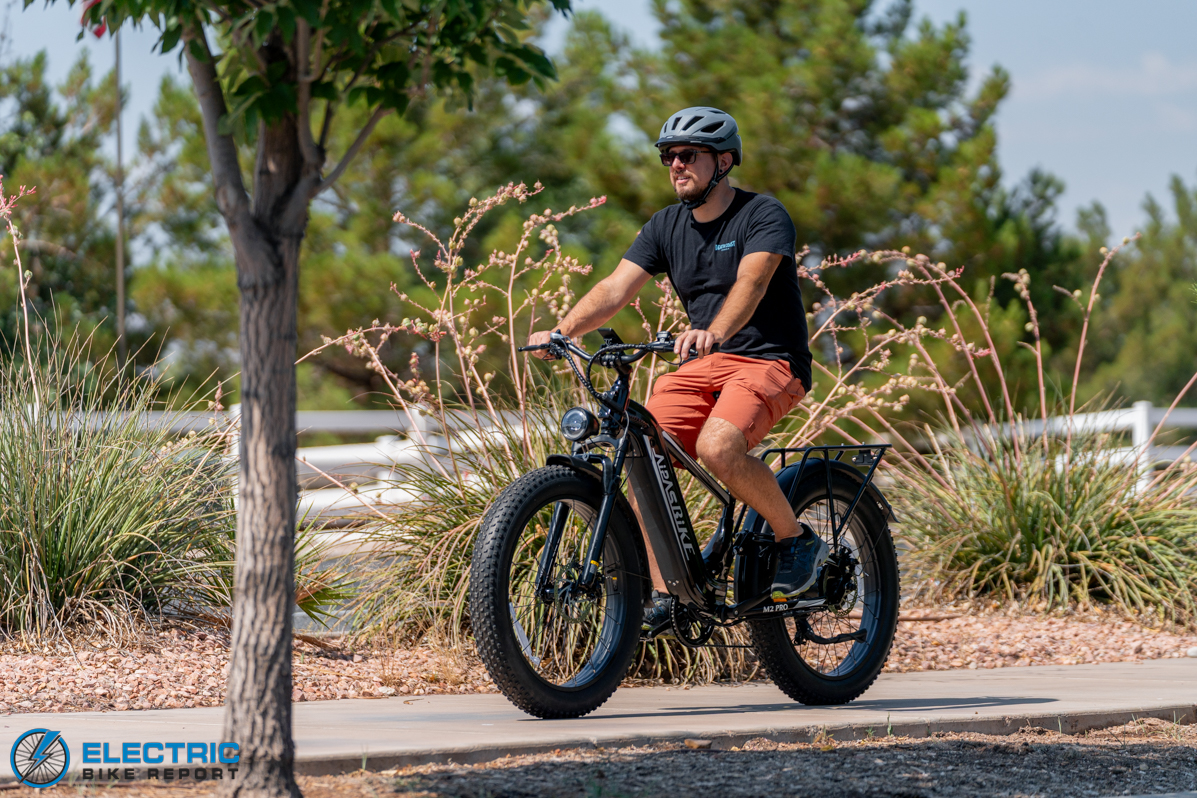
Aipas offers four colors for the M2 Pro: Green, Blue, Gray, and Black.
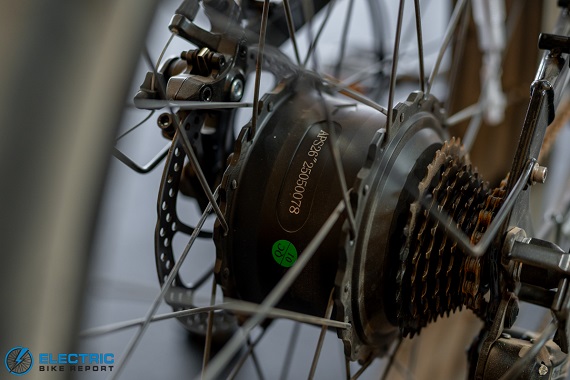
The bike’s powerful 1000W rear-hub motor provides up to 110 Nm of torque and peaks at 1800W.
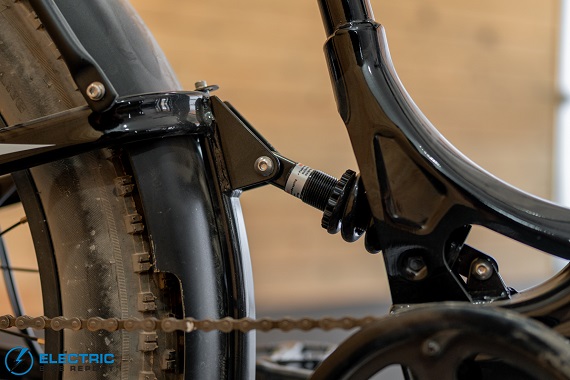
Many e-bikes in the M2 Pro’s price range offer front suspension, but this bike’s rear shock sets it apart.
Aipas M2 Pro Review: Speed Test
While Aipas advertises that the M2 Pro can reach speeds of over 36 mph, the bike ships in a more restricted (and more widely street-legal) Class 2 mode, where the bike’s throttle and pedal assist system are limited to 20 mph.
We tested the bike in our Speed Test using both its Class 2 and Unrestricted modes to see how fast it could go in the real world. The M2 Pro’s pedal assist system (PAS) has five power levels with different speed restrictions, so we also used this test to find its limits in each PAS setting. Finally, we tested the bike’s throttle to understand its acceleration force.
During the test, I rode the M2 Pro on a flat, paved section of our local shared-use trail system. The data I collected from my Class 2 and Unrestricted mode speed tests is shown above.
When in Class 2 mode, the data shows consistent increases in speed/power when moving through the M2 Pro’s first four pedal assist levels. Due to its 20 mph ceiling, the difference when moving from PAS 4 to 5 was somewhat less than between the previous settings, though it’s worth noting that the bike did exceed the Class 2 limit by a small margin.
In the Unrestricted mode, the M2 Pro’s data showed a more exponential curve, versus the Class 2 mode’s relatively linear pattern. The first three PAS levels shared identical speed limits to those of the Class 2 test, but PAS 4 and 5 ramped up significantly in power to deliver on Aipas’ advertised, adrenaline-fueled top speeds.
Let me just take a moment to say that this bike can move! Riding at 36.5 mph was fun and exhilarating, and overall, the M2 Pro handled it well.
In practice, the bike’s feel reflected its data; when in Class 2 mode, its speed limits felt intuitive and well-balanced across all five PAS levels. In the bike’s Unrestricted mode, its first few PAS levels provided measured increases in speed, while kicking things up progressively in its highest power levels.
When testing the bike’s throttle, its acceleration felt strong, but not too punchy. The bike picked up speed quickly (to the same limits as the pedal assist system) while also feeling relatively controlled and approachable.
With a 1000W rear-hub motor and speeds that can approach 40 mph, it’s important to note that the M2 Pro is an unrestricted e-bike that falls outside of the 3-Class system many cities and states use to dictate where they can ride. As such, riders may need to get the bike registered for street use.
Otherwise, the M2 Pro has a capable motor that’s able to deliver a lot of power (or a little) when it’s wanted; the bike’s preset speed limits allow riders to choose their preferred feel. As it ships, the bike offers five controlled steps in speed, while its Unrestricted mode should have enough power to satisfy even the most dedicated speed junkies!

The bike’s motor, full suspension, and knobby fat tires make it stable and powerful enough for off-road adventuring.
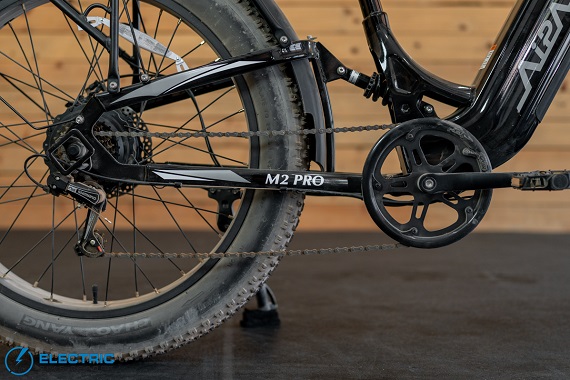
The M2 Pro’s 7-Speed Shimano Tourney drivetrain is a functional, affordable setup.
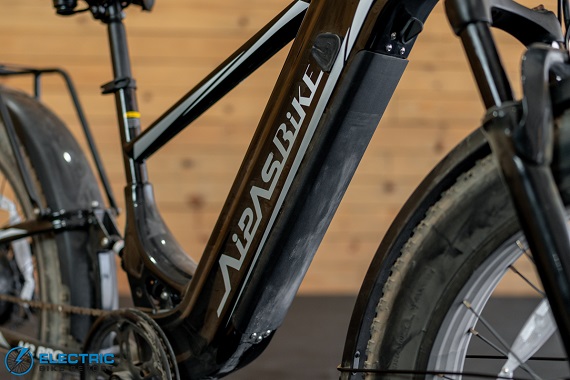
A large 48V, 840 Wh battery is fully integrated into the bike’s down tube.
Aipas M2 Pro Review: Range Test
We tested the Aipas M2 Pro’s battery life and minimum/maximum range in two tests using the method explained above. Aipas advertises that the bike should have a range of 40 to 85 miles when using pedal assist. Our tests showed that these numbers may be somewhat hopeful—but still highly practical—as our team of riders covered 23.2 and 74 miles.
When compared with similar models we tested previously, the Aipas M2 Pro straddled their average results; the pool of e-bikes we used for comparison averaged 33.8 and 67.6 miles using their highest and lowest practical power levels, respectively.
All bikes, including the Aipas, were tested using their Class 2 settings whenever possible; as such, riders using the M2 Pro’s Unrestricted mode or its throttle should expect fewer miles.
A few factors likely played a role in the M2 Pro’s results:
First, the bike’s 1000W rear hub motor is more powerful than the 750W motors found on most bikes we compared it with, so when riding in its highest PAS setting, it expended battery charge faster. See below for a more detailed explanation.
Second, its 840 watt-hour (Wh) battery is somewhat larger than the average of 799 Wh carried by similar models, so when using its lowest assist level, it had more fuel to keep it riding longer. Any advantage given in the high power test was negated by other factors.
Thirdly, its weight of 94 lbs is significantly higher than the average of 80.6 lbs among similar models we’ve tested. This higher weight likely required more power to overcome when starting from a complete stop or climbing hills, which would have lowered the motor’s overall efficiency in both portions of the test.
Finally, e-bikes equipped with cadence sensors (like the M2 Pro) tend to be less efficient than those with torque sensors (like many of the bikes used for comparison). The power output of motors paired with torque sensors fluctuates depending on the rider’s effort. In contrast, the M2 Pro’s motor puts out a constant, unchanging flow of power as long as its cranks are turning. This factor often plays most into the max PAS test.
By dividing the bike’s battery capacity by the number of miles (mi) it traveled, we can get a measure of the motor’s efficiency; in PAS 5, the bike burned 36.2 Wh/mi, while in PAS 1, it used 11.4 Wh/mi. The pool of bikes we used for comparison averaged just 23.6 Wh/mi in PAS 5, while using a relatively comparable 11.8 Wh/mi in their lowest power level.
The above differences in watt-hours per mile are reflected closely by the M2 Pro’s range test results; it differed much more from the average in its max PAS test than it did in its lowest power level.
We consider the M2 Pro’s range to be practical for commuting, off-road adventuring, leisure riding, and more. However, it is important to note that riders planning to spend a majority of their time using the bike’s Unrestricted mode and highest PAS level (or throttle) should expect relatively limited range.
Regardless, the bike’s included 2-amp charger should take around 9 hours to recharge the battery.
Aipas M2 Pro Review: Hill Test
As with the previous test section, the method we used when testing the Aipas M2 Pro in our Hill Test is explained above.
Similar models (including some of the best fat tire e-bikes we’ve tested) averaged 1:52 and 1:51 using their throttle and PAS, respectively. The M2 Pro’s 1:56 and 1:51 results were roughly the same, making its performance relatively average overall (in a category that typically performs very well).
Before moving on, it’s important to acknowledge that, when analyzing e-bikes of any style, average performance is great; it’s an indication that the bike is appropriately specced and able to keep pace with its peers. This was an interesting case, however, because on paper, the Aipas M2 Pro appears significantly more powerful than average.
Its 1000W motor peaks at 1800W while producing up to 110 Newton meters (Nm) of torque. The pool of similar models we’ve tested were often equipped with 750W motors, which peak at an average of 1210W and produce an average of 96 Nm of torque. By those numbers alone, we’d expect it to dominate our Hill Test scores.
The bike’s higher-than-average 94-lb weight likely made it more difficult for the M2 Pro’s motor to climb hills; again, the average among similar models used for comparison was 80.6 lbs. Considering the bike’s average performance, the M2 Pro’s motor and weight are clearly well balanced.
In my personal testing, the bike was fast, capable, and effective when riding uphill regardless of whether I pedaled or relied on its throttle. Pedaling was easy and relaxed because the motor did a majority of the work, while throttling felt completely effortless and similarly speedy. I remember being pleasantly surprised at how fast I was riding!
Our test results and my personal experience show that the bike is plenty capable of dealing with intimidating climbs while allowing riders to choose their preferred approach.
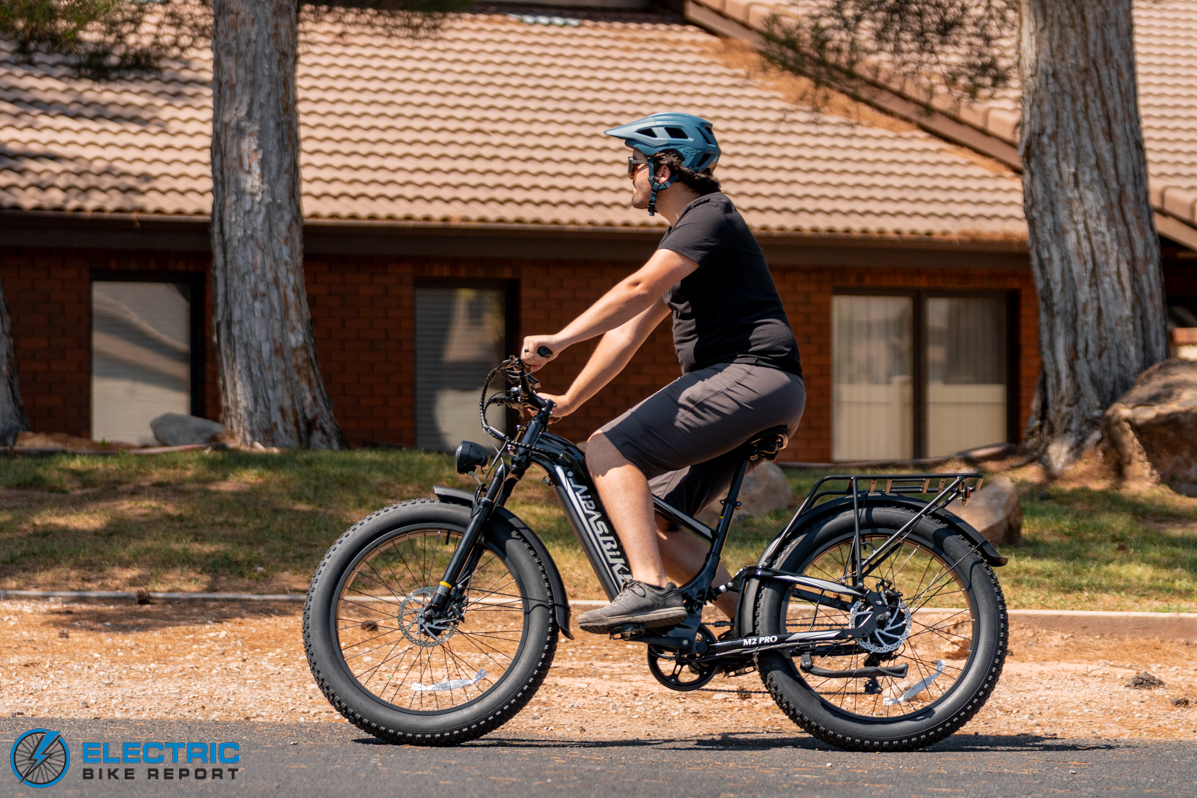
With a maximum speed of over 36 mph, this bike can rip!
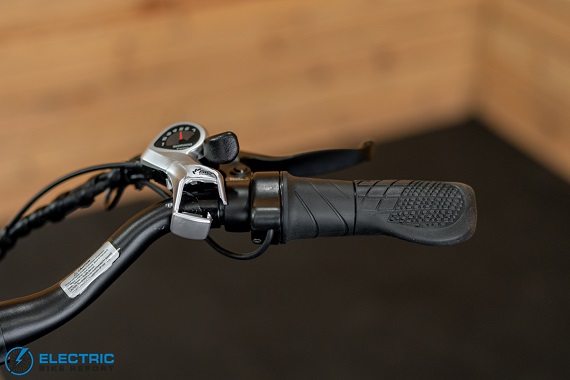
The bike’s half-twist throttle has power, but isn’t so punchy that it feels out of control.

The M2 Pro is equipped with an unbranded mechanical disc brake system.
Aipas M2 Pro Review: Brake Test

Using the process explained above, we determined the Aipas M2 Pro’s average stopping distance to be 29’ 6”, which was significantly longer than the average of 21’10” among similar e-bikes we’ve tested.
We consider roughly the 25’ mark to be the point at which we recommend changes to improve performance, so what happened in this test, and how would we solve it?
There are two main factors that likely influenced the Aipas M2 Pro’s performance: its weight and brake system.
As referenced above, the M2 Pro weighs a hefty 94 lbs, making it one of the heaviest e-bikes of its style we have reviewed. In the context of e-bikes and braking, a high weight makes the bikes more difficult to slow down, as its brake system needs to overcome more inertia.
Considering that much of the M2 Pro’s weight is made up by its frame, suspension, motor, and battery (all things inherent to its design), this aspect of the bike isn’t something that we can recommend an easy fix for.
The bike’s brake system is a different story. The M2 Pro is equipped with a mechanical disc brake system that uses 180mm rotors. We’ve tested similar systems on similarly affordable—but significantly lighter—e-bikes and found them to perform relatively well, but the M2 Pro’s weight and speed capabilities did not seem to be an ideal match.
On such a heavy e-bike with the capability of reaching nearly 40 miles per hour, we recommend that Aipas upgrade the M2 Pro’s brake system in the future with a hydraulic brake system. We would expect a similar setup with 2-piston calipers and 180mm rotors to improve its performance, though 4-piston calipers, thicker 180mm rotors, and/or 203mm rotors would likely be a better fit for its speed and weight.
As it is, I found the bike’s extended stopping distance noticeable during my time on the bike, though its braking force could be improved by applying enough pressure to the brake levers. I learned to give myself some extra distance when coming to a stop, which felt manageable when riding at lower speeds.
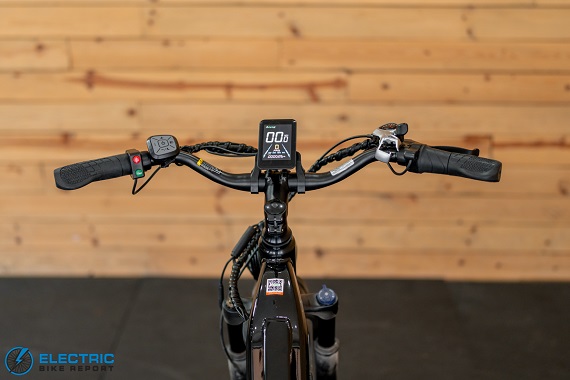
We found the curved 660mm handlebars (and the resulting riding position) comfortable and ergonomic.
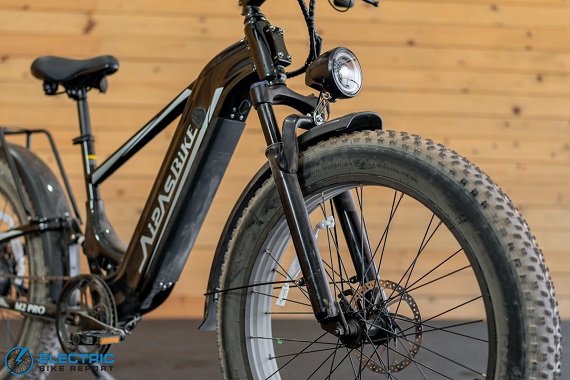
A coil suspension fork complements the M2 Pro’s rear shock with 100mm of travel and lockout/preload adjustment features.
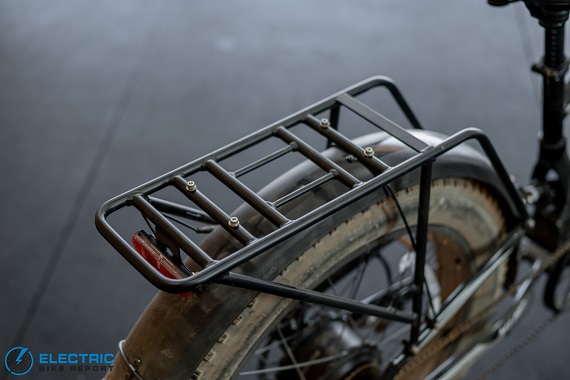
The bike’s cargo rack makes it useful for running errands, camping trips, etc.
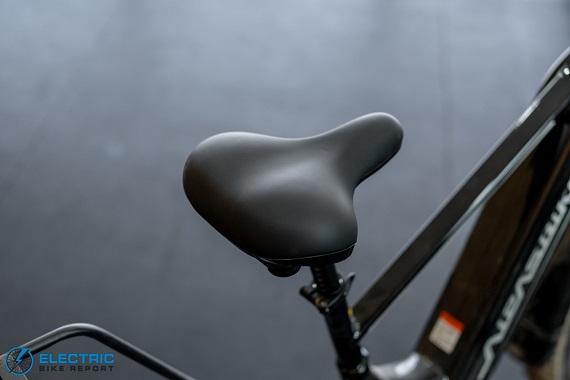
We liked the bike’s cushy and supportive saddle.
Aipas M2 Pro Review: Ride Quality
A more subjective topic than our performance test sections above, ride quality is a measure of how a bike functions and feels to ride. Overall, the M2 Pro met our expectations and, in some cases, pleasantly surprised us—though it’s important to note that there are a few potential tradeoffs for its remarkably affordable price.
Aipas’s website states that the bike is sized for riders between 5’8” and 7’0”, making it suitable for riders of relatively average height to those who are extremely tall. Based on my personal experience, however, the high end of the bike’s advertised height range seems hopeful.
At 5’11”, I felt generally comfortable while riding the bike, but I would likely make some adjustments for personal comfort, with the first item being a longer seatpost. The M2 Pro offers just 4 inches of saddle height adjustment, and even with the saddle at its highest, my knees were bent more than I prefer for pedaling efficiency.
With that in mind, it’s important to note that the motor and pedal assist system are powerful enough to largely offset the difference; I never felt pain or discomfort in my knees from the pedaling position.
The bike’s reach felt appropriate and comfortable, with ergonomically-curved handlebars positioning my upper body in a mostly-upright posture. I also liked the saddle and rubber grips. The overall riding position felt slightly sporty but also relaxed and strain-free.
A major appealing feature of the M2 Pro is its full suspension, which includes a coil shock at the tail end and a coil fork with 100mm of travel. The combination of the bike’s suspension and fat tires made the ride smooth and enjoyable, though the bike could be a bit creaky at times.
As far as handling goes, the bike steered predictably, but due to its weight and long wheelbase, it wasn’t the most nimble e-bike I’ve tested. In comparison with other fat tire e-bikes, it wasn’t too far from the norm, but riders who are used to a “regular” bike may be somewhat surprised by its size; maneuvering it while off the bike and/or lifting it onto a vehicle rack may require some effort.
The M2 Pro’s tires, as is typical for a fat tire e-bike, provide great stability while riding, and include knobby tread for traction in off-road environments. These factors make this style of bike popular for both comfort and versatility; fat tires feel confidence-inspiring when cornering and capable of handling loose, slippery terrain.
Operating the bike is generally simple and straightforward; the user interface is relatively basic. In addition to the central color display, the left handlebar hosts a control panel and a module for the lights and horn, while the right side has a twist throttle and over-the-bar thumb shifter for the 7-speed drivetrain.
As one might expect for an e-bike under $1,000, the M2 Pro uses a number of entry-level components, including its drivetrain. The combination of a twist throttle and over-the-bar shifter is not uncommon in our experience, but we typically prefer the trigger-style shifter common with 8-speed drivetrains to the M2’s thumb shifter—especially when riding off-road.
It’s inevitable that e-bikes in this price tier have to make some compromises with their components, so I cannot fault Aipas for outfitting the bike as it comes, but it’s important to consider that some parts may need more frequent maintenance as a result. The M2 Pro’s suspension, for example, performed well in our (mostly on-road) testing, but we can’t speak to its longevity with prolonged exposure to rough off-road conditions.
Overall, I found the M2 Pro to be comfortable and generally well-equipped for its price. Aipas seems to have found a great balance between comfort, price, and performance; the bike offers many appealing features, including a smooth, easy, and speedy ride.
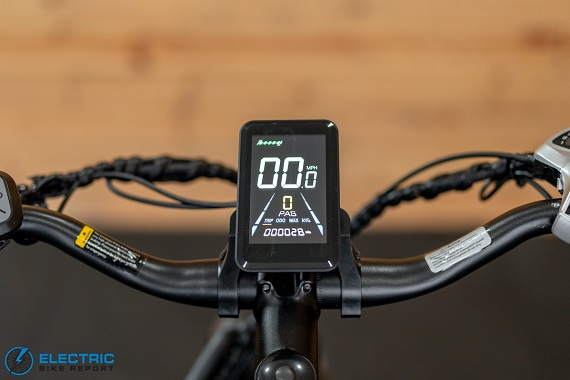
It’s nice to see a full-size color display on an e-bike in this price range!

The M2 Pro’s integrated LED headlight is surprisingly bright.

The bike’s control panel and a module for its lights and horn rest on the left handlebar.
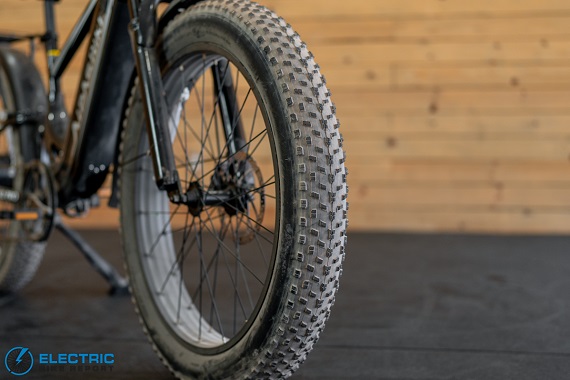
Knobby 26×4” fat tires are what make a fat-tire e-bike a fat-tire e-bike!
Aipas M2 Pro Review: Summary / Where to Buy
In our experience, it’s not easy to find a full-size e-bike for less than $1,000. Of the handful we’ve found and tested, most are relatively barebones; they might sacrifice essential things like a display or have batteries awkwardly bolted to their frame.
In contrast, the Aipas M2 Pro promises speed, power, distance, comfort, and performance, along with a list of impressive specs and an ultra-low price. Our testing showed that, while there were some compromises made to achieve such an affordable price and a few potential overestimations of its capabilities, it’s still an impressive e-bike that offers solid value for the money.
With one major exception, the bike generally scored well in our testing. It delivered high speeds for those who want them and more controlled options for those who don’t—along with a balanced distribution of speed limits. It also proved to have practical range (when its speeds are controlled), great climbing power, and a smooth, enjoyable ride.
Our most notable point of critique is related to the M2 Pro’s brake system; we recommend that Aipas upgrade to a more powerful and effective brake system to balance the bike’s weight and speed. Additionally, potential buyers should be aware that the bike is large and heavy, while its motor power and speed may require it to be registered for street use.
Those aware of and comfortable with these tradeoffs will find a bike that offers serious bang for the buck! The M2 Pro is equipped for commuting and leisure riding, offers utility for running errands and exploring fire roads or multi-use trails, and is potentially even suitable for hunting or overlanding adventures.
Happy Riding! Make sure to let us know if you have any questions or if you think we left anything out in this review of the Aipas M2 Pro down in our comments section.




I bought a freesky wildcat with a 1000watt motor full suspension also it has the same controller as this one tested it can hit 36mile top speed it’s heavy too it came with 4piston brakes it does good but it is heavy I paid more than this one I think the tested bike is a good buy I would still recommend this bike for the money it’s a great deal
You pretty much nailed the article. A Few further notes.
1. I agree totally with your opinion on the braking system. But, they appear to be working better as they break in.
2. You briefly touched upon it but integrated into the PAS control on the left there is a USB A port which you can utilize to keep your phone or a wireless Bluetooth speaker powered. This is good to know as when utilizing your phone for navigation it can drain the battery more rapidly.
3. This bike does have a long wheel base, 52 inches. So long on fact as there is only one place I have found which makes a dual bike rack which can actually accommodate this bike, Cravot Cyber rack at $465.00
4. I also concur with you on the need for a longer seat post, as I am 6’1″. I looked on their web site to determine the diameter of the seat post and it claimed 27.2 mm, but this is incorrect, it’s 30.8 mm I believe. I purchased a 450 mm shock absorbing seat post only to realize i need a bigger diameter.
5. The specified rider heights too are also a bit too narrow. My girlfriend is 5′ 3″, 115 pounds, and can ride it just fine, but she is a bit of a bad ass!
We also have front and rear racks on ours, also panier bags (saddle bags) and also just added basket liners so that small stuff does not fall through the baskets. The liners, both front and rear baskets, i got, also come with rain flys which are highly water resistant and bungee cargo nets. Ours also came with a free phone holder and free bike lock. I also added more small items. I holder for my JBL GO3 speaker, and a rearview mirror. These bike are a great value proposition.
Aipas has been lying about the batteries in the M2 Pro. They do NOT use Samsung 21700 cells like they claim (have since removed from their site but are still viewable from wayback machine). They actually use cheap EVE 18650 cells instead. Please hold them accountable and please remove this incorrect information from your site.